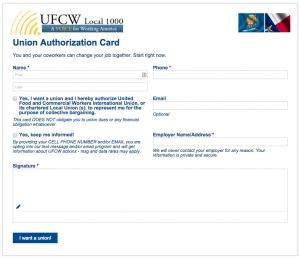 We have sent out several updates recently announcing the use of electronic means of collection signatures for union organizing drives. While there is greater potential for fraud and abuse with electronic systems, the requirements to qualify as a valid system are more stringent than for paper cards or petitions. Understanding what they are may provide the opportunity to challenge a request for election. The attorneys at FranczekRadelet provided a nice summation of the process:
We have sent out several updates recently announcing the use of electronic means of collection signatures for union organizing drives. While there is greater potential for fraud and abuse with electronic systems, the requirements to qualify as a valid system are more stringent than for paper cards or petitions. Understanding what they are may provide the opportunity to challenge a request for election. The attorneys at FranczekRadelet provided a nice summation of the process:
Submissions supported by electronic signature to establish a showing of interest must contain the following information:
- The signer’s name;
- The signer’s email address or other known contact information (e.g., social media account);
- The signer’s telephone number;
- The language the signer agreed to (e.g., that the signer wishes to be represented by the union for collective bargaining purposes);
- The date the electronic signature was submitted; and
- The name of the employer of the employee.
In addition to these requirements, the party submitting the electronic signatures must also submit a declaration identifying what technology was used to obtain the signatures, and how its controls ensure that (1) the electronic signature is that of the signatory employee, and (2) the employee herself signed the document. The declaration also must identify that the electronically transmitted information regarding what the employee signed, and when the employee signed, was actually the same information seen and signed by the employee. If the signature technology used does not lend itself to this type of verification, the party must submit evidence that, after the electronic signature was obtained, the party promptly transmitted a communication to the employee confirming all of the information contained in paragraphs (a) through (f) above.
The joint employer discussion continues to roll forward. The Education and Workforce Committee is pushing back at the DOL for bringing OSHA into the joint-employer determination process, charging that such a broadened responsibility lessens OSHA’s ability to do the job it was created to accomplish. In the meantime, NLRB General Counsel Griffin is asking the board to overturn Oakwood Care Center, which prevented contingent workers from organizing with permanent employees, and return to the prior standard (M.B. Sturgis). Because of the recent widening of the joint employer definitions under the rulings in Browning-Ferris and Miller & Anderson, the old M.B. Sturgis standard would be even more potent. In Pennsylvania, the state Senate passed a bill that would prohibit the transfer of public sector worker dues to political organizations, while in New York City, carwash owners are suing the city over a law designed to favor unionized companies. At issue are new regulations that require owners of nonunionized carwashes to post a $150,000 surety bond before obtaining a license. Unionized operations would pay only $30,000.




